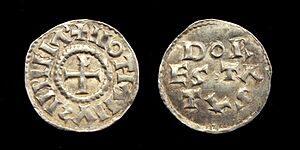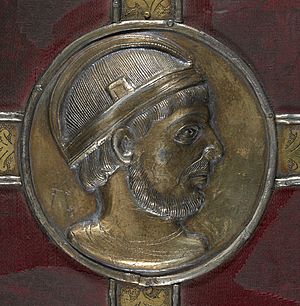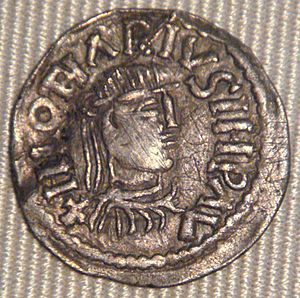Lothair I facts for kids
Quick facts for kids Lothair I |
|
|---|---|
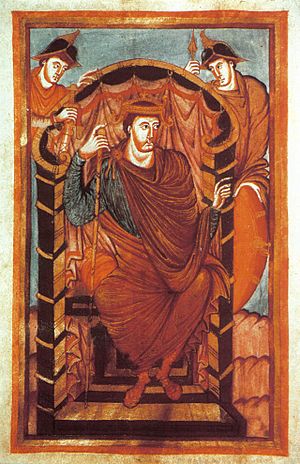
A picture of Lothair I from a gospel book, around 849–851. It is now in the Bibliothèque nationale de France.
|
|
| Holy Roman Emperor | |
| Reign | As Emperor: 817–855; As King of Italy: 822–855 As King of Middle Francia: 843–855 |
| Coronation | By his father: 817, Aachen; By Pope Paschal I: 5 April 823, Rome |
| Predecessor | Louis the Pious |
| Successor | Louis II |
| Born | 795 |
| Died | 29 September 855 (aged 59–60) Prüm |
| Burial | Prüm |
| Consort | Ermengarde of Tours |
| Issue | Louis II Lothair II Charles of Provence Carloman (d. 853) Hiltrude Berta Gisela Rotrude |
| House | Carolingian Dynasty |
| Father | Louis the Pious |
| Mother | Ermengarde of Hesbaye |
Lothair I (born in 795 – died 29 September 855) was an important ruler in Europe. He was the Holy Roman Emperor from 817 to 855. For some of that time, he ruled alongside his father. He was also the governor of Bavaria (815–817), the King of Italy (818–855), and the King of Middle Francia (840–855).
Lothair was the oldest son of Emperor Louis the Pious and his wife, Ermengarde of Hesbaye. Lothair often led his brothers, Pepin I of Aquitaine and Louis the German, in rebellions against their father. They were unhappy because their father wanted to give part of the empire to their half-brother, Charles the Bald.
After their father died, Charles and Louis teamed up against Lothair. This led to a three-year civil war (840–843). The fighting between the brothers caused the large Frankish Empire, built by their grandfather Charlemagne, to break apart. This breakup helped create the countries we now know as France and Germany.
Contents
Early Life and Becoming Emperor
Lothair was born in 795. His father, Louis the Pious, was the son of the powerful Emperor Charlemagne. We don't know much about Lothair's early life. He probably grew up at his grandfather Charlemagne's court.
In 814, Charlemagne died, and his son Louis the Pious became the new Emperor. The next year, in 815, Lothair was sent to govern Bavaria for his father.
In 817, Louis the Pious made a plan for how his empire would be divided. This plan was called the Ordinatio Imperii. In it, Louis named Lothair as his main heir. Lothair would be the ruler over his younger brothers, Pippin of Aquitaine and Louis the German. He would also rule over his cousin, Bernard of Italy. Lothair, who was 22, was then crowned as a joint emperor with his father in Aachen.
At the same time, Pippin and Louis were given their own smaller kingdoms. After Bernard of Italy died, Lothair also received the Kingdom of Italy. In 821, Lothair married Ermengarde of Tours.
In 822, Lothair took control of Italy. On April 5, 823, he was crowned emperor again by Pope Paschal I in Rome. In 824, Lothair created a law called the Constitutio Romana. This law said that the emperor had the most power, even over the Pope. He also made other laws to help govern Italy well.
When Lothair returned to his father's court, his stepmother, Judith, convinced him to agree to a plan. She wanted her son, Charles the Bald, to have his own kingdom. This happened in 829 when Charles was given a region called Alemannia. However, Lothair soon changed his mind. For the next ten years, he was often in conflict with his father over how the empire should be divided. Sometimes he was in charge, and other times he was sent away to Italy. He would sometimes join his brothers against his father, and other times fight against his brothers.
The Empire Breaks Apart
The first rebellion against Emperor Louis the Pious started in 830. All three brothers fought their father and removed him from power. But in 831, their father was put back on the throne. He then took away Lothair's imperial title and gave Italy to Charles.
Another rebellion began in 833. Again, Louis the Pious was removed from power. But Lothair, with the help of loyal people from Italy, managed to keep Italy and his imperial title through all the later divisions of the empire by his father.
When Louis the Pious was dying in 840, he sent his imperial symbols to Lothair. Lothair, who was 45 years old, then claimed the entire empire for himself. But his brother Louis the German and his half-brother Charles did not agree. They formed an alliance against Lothair.
A major battle happened at Fontenay-en-Puisaye on June 25, 841. Even though Lothair and his nephew fought bravely, Lothair was defeated. He fled to Aachen. He gathered new troops and started a war of looting. But his brothers' forces were too strong. Lothair took what treasures he could and left his capital city to them. He tried to get support from a group called the Stellinga, but his brothers quickly put down that rebellion.
Peace talks began, and in June 842, the brothers met. They agreed on a plan that eventually led to the Treaty of Verdun, signed in August 843. With this treaty, Lothair kept his imperial title. He also received northern Italy and a long strip of land from the North Sea to the Mediterranean. This land followed the Rhine and Rhône rivers and included regions like Lorraine, Alsace, Burgundy, and Provence.
Lothair soon gave Italy to his oldest son, Louis. He stayed in his new kingdom. He often argued and then made up with his brothers. He also tried to protect his lands from attacks by the Northmen (also known as Vikings) and the Saracens. In 845, a count named Fulcrad led a rebellion in Provence. Lothair stopped it, and then the count joined him on a trip to fight the Saracens in Italy in 846.
Lothair's Final Years and Legacy
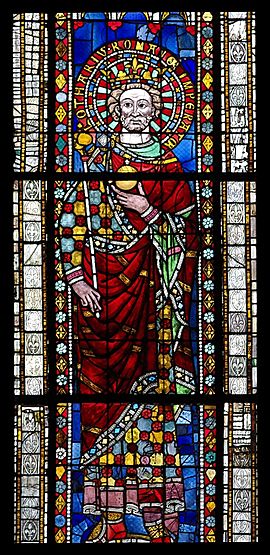
In 855, Lothair became very ill. He knew he would not get better. So, he gave up his throne and divided his lands among his three sons. On September 23, he went to live in the monastery of Prüm. He died there six days later. He was buried at Prüm, where his remains were found in 1860.
In the same year, Lothair's kingdom was divided among his three sons. This agreement was called the Treaty of Prum:
- His oldest son, Louis II, received Italy and the title of emperor.
- His second son, Lothair II, received Lotharingia.
- His youngest son, Charles, received Provence.
Family
Lothair married Ermengarde of Tours in 821. She died in 851. They had several children:
- Louis II (825–875): He was crowned King of Italy in 844 and Emperor in 850.
- Hiltrude (826–865): She married Berengar of Spoleto.
- Ermengard (around 825–849)
- Bertha (around 830–852): She became an Abbess (leader of a convent).
- Gisela (around 830–856): She was an abbess at San Salvatore in Brescia.
- Lothair II (835–869): He took over part of his father's kingdom.
- Rotrude (around 840)
- Charles (845–863): He was given Provence, Lyon, and Burgundy.
See also
 In Spanish: Lotario I para niños
In Spanish: Lotario I para niños


